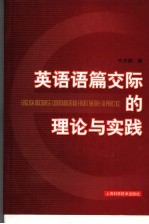图书介绍
英语语篇交际的理论与实践PDF|Epub|txt|kindle电子书版本网盘下载

- 于万锁著 著
- 出版社: 上海:上海科学技术出版社
- ISBN:9787532390700
- 出版时间:2007
- 标注页数:360页
- 文件大小:11MB
- 文件页数:372页
- 主题词:英语-研究
PDF下载
下载说明
英语语篇交际的理论与实践PDF格式电子书版下载
下载的文件为RAR压缩包。需要使用解压软件进行解压得到PDF格式图书。建议使用BT下载工具Free Download Manager进行下载,简称FDM(免费,没有广告,支持多平台)。本站资源全部打包为BT种子。所以需要使用专业的BT下载软件进行下载。如BitComet qBittorrent uTorrent等BT下载工具。迅雷目前由于本站不是热门资源。不推荐使用!后期资源热门了。安装了迅雷也可以迅雷进行下载!
(文件页数 要大于 标注页数,上中下等多册电子书除外)
注意:本站所有压缩包均有解压码: 点击下载压缩包解压工具
图书目录
Chapter One Introduction1
提要1
本章英汉术语对照表2
1.1 Discourse and communication4
1.1.1 The definition of discourse6
1.1.2 Discourse features7
1.1.3 Basic factors affecting discourse communication14
1.2 Discourse analysis and its object of study15
1.3 Two approaches to discourse research18
1.3.1 The views of Structural Linguistics18
1.3.2 The views of Functional Linguistics19
1.4 Conclusion21
Chapter Two Discourse and Context23
提要23
本章英汉术语对照表24
2.1 Introduction to context26
2.2 The close link between discourse and context27
2.3 Discourse context31
2.3.1 Immediate context31
2.3.2 Remote context33
2.4 Discourse world and real world34
2.5 Contextual features and discourse interpretation36
2.5.1 Contextual features36
2.5.2 Three principles and discourse interpretation40
2.6 Conclusion44
Chapter Three Information in Discourse46
提要46
本章英汉术语对照表47
3.1 Information status49
3.2 Information structure51
3.3 Theme-rheme structure54
3.4 Thematic development in discourse57
3.5 Conclusion67
Chapter Four Discourse Topic69
提要69
本章英汉术语对照表70
4.1 The definition of topic72
4.2 Topic hierarchy in discourse78
4.3 Topic-marking devices80
4.3.1 Paragraph81
4.3.2 Paratone83
4.3.3 Explicit linguistic markers84
4.4 Topic-emphasizing devices86
4.4.1 Using explicit indicators86
4.4.2 Using left-displaced structures87
4.4.3 Lengthening the discussion of the topic in discourse89
4.4.4 Using special constructions90
4.5 Topic development92
4.5.1 Topic continuity92
4.5.2 Topic change93
4.5.3 Topic break96
4.6 The functions of topic98
4.7 Conclusion98
Chapter Five Discourse Stance100
提要100
本章英汉术语对照表101
5.1 Definition of stance102
5.2 Types of stance in discourse103
5.3 Stance marking devices108
5.4 Discourse stance and ideology111
5.5 Conclusion117
Chapter Six Relations between Discourse Structures119
提要119
本章英汉术语对照表120
6.1 Vocabulary and discourse patterns124
6.1.1 Discourse-organizing words and the problem-solution pattern124
6.1.2 Discourse-organizing words and the claim-counterclaim pattern128
6.1.3 Discourse-organizing words and the question-answer pattern130
6.1.4 Discourse-organizing words and the general-particular pattern131
6.1.5 Discourse-organizing words and the opportunity-taking pattern134
6.1.6 The use of the common patterns in the natural discourse135
6.2 Grammar and discourse types136
6.2.1 Sentence types and genres136
6.2.2 Tense,aspect,voice and common genres137
6.3 Clause relations144
6.3.1 Logical relations146
6.3.2 Semantic relation152
6.3.3 Pragmatic relation152
6.4 Discourse orderings153
6.4.1 The chronological order154
6.4.2 The spatial order158
6.4.3 The cognitive orders160
6.4.4 The abnormal orders161
6.5 Conclusion164
Chapter Seven Cohesion and Coherence in Discourse165
提要165
本章英汉术语对照表166
7.1 The relationship between cohesion and coherence168
7.1.1 The cohesive-but-not-coherent viewpoint168
7.1.2 The coherent-but-not cohesive viewpoint169
7.1.3 The cohesion-as-the-foundation-for-coherence viewpoint170
7.2 Cohesion in discourse170
7.2.1 Reference171
7.2.2 Ellipsis177
7.2.3 Substitution179
7.2.4 Conjunction181
7.2.5 Lexical cohesion185
7.3 Coherence in discourse189
7.3.1 Theories explaining coherence189
7.3.2 Strategies for establishing coherence195
7.4 Conclusion200
Chapter Eight Common Spoken Discourse Communication202
提要202
本章英汉术语对照表203
8.1 The characteristics of spoken discourse207
8.2 The production of spoken discourse208
8.2.1 The planning of discourse210
8.2.2 The planning of sentence212
8.2.3 The planning of constituent213
8.2.4 The articulatory program213
8.2.5 The articulation213
8.3 Oral discourse communication in language learning and teaching214
8.3.1 The characteristics of classroom lessons214
8.3.2 Lecture227
8.3.3 Story-telling and Labov's model of narrative234
8.4 Discourse analysis and listening comprehension test238
8.4.1 The characteristics of directions for listening comprehension239
8.4.2 The characteristics of the stem-and-alternative section240
8.4.3 The characteristics of the main body243
8.4.4 An analysis of a dialogue244
8.4.5 An analysis of a monologue249
8.5 Conclusion253
Chapter Nine Common Written Discourse Communication255
提要255
本章英汉术语对照表257
9.1 Common discoursal problems in Chinese students'compositions260
9.1.1 Inappropriate discourse organization261
9.1.2 Irrational topic development267
9.1.3 Indefinite discourse stance269
9.1.4 Insufficient information and improper thematic development273
9.1.5 Incorrect and inappropriate use of discourse components275
9.2 Methods for overcoming the discoursal problems in English writing280
9.3 The planning of written discourse283
9.4 The 472-discourse-producing approach285
9.4.1 Four ways of introduction286
9.4.2 Seven ways of development295
9.4.3 Two ways of conclusion312
9.5 Discourse analysis and cloze test314
9.5.1 A three-step model for analyzing cloze discourses314
9.5.2 Anexemplification of discourse analysis in the cloze test316
9.6 Discourse analysis and reading comprehension328
9.6.1 A discourse-based approach to reading comprehension328
9.6.2 Different reading comprehension questions and their solutions329
9.7 Conclusion352
References353